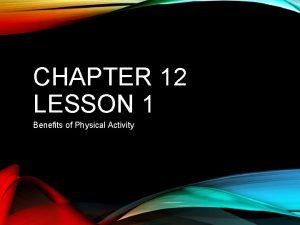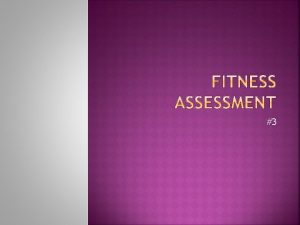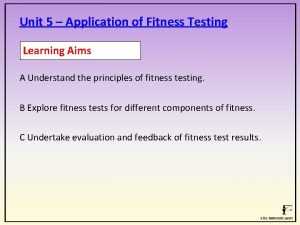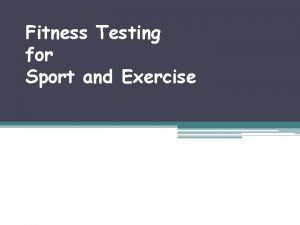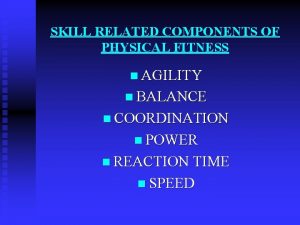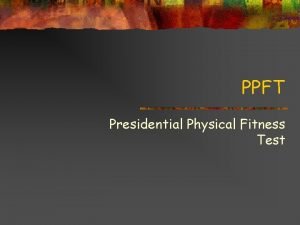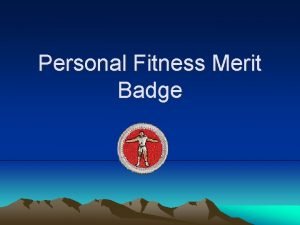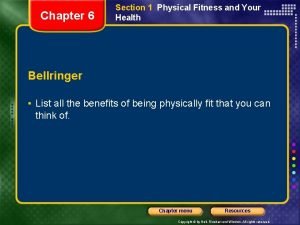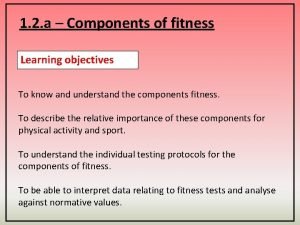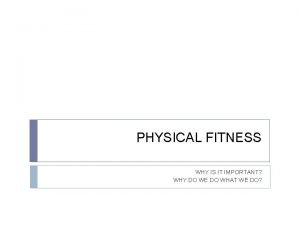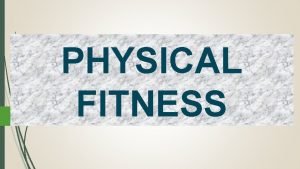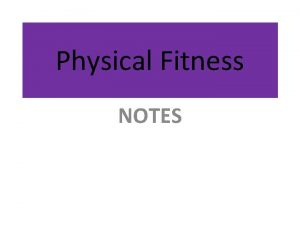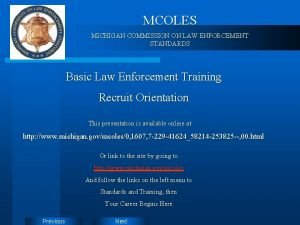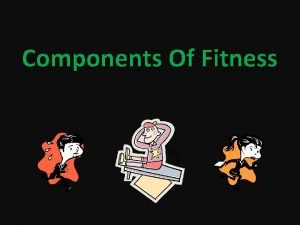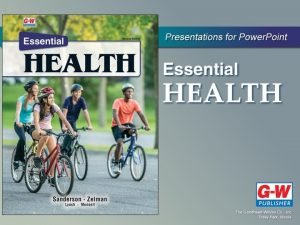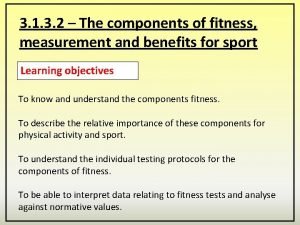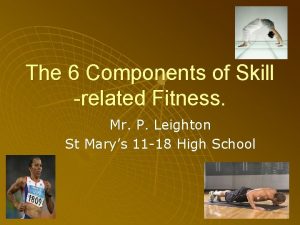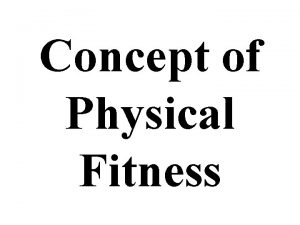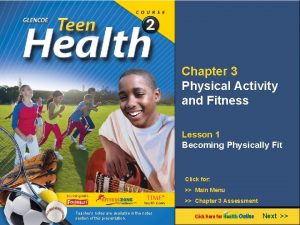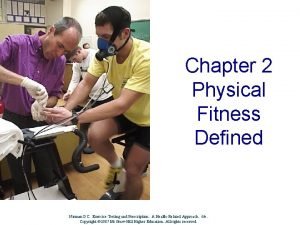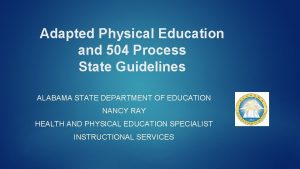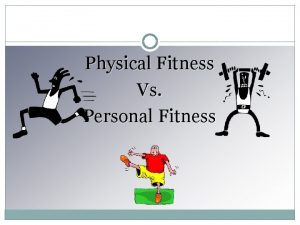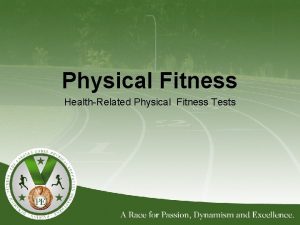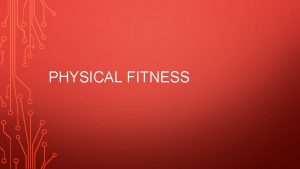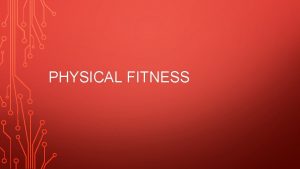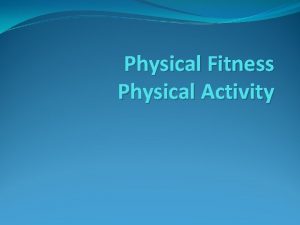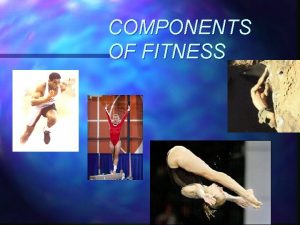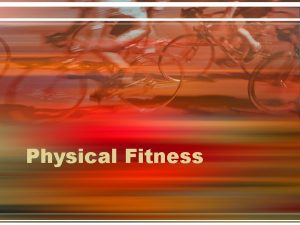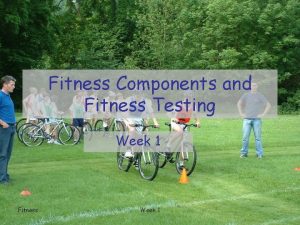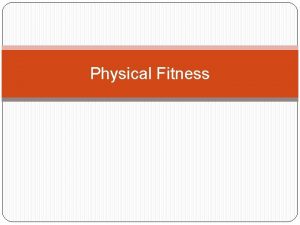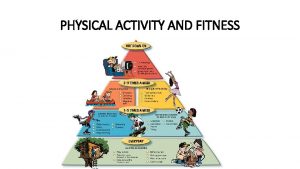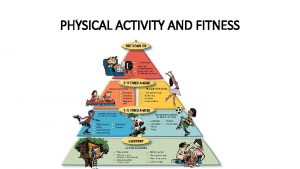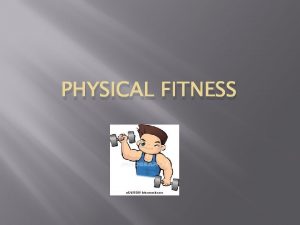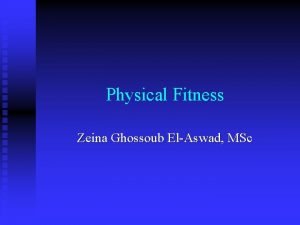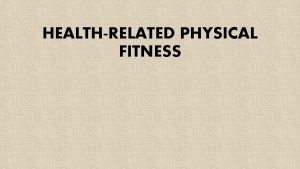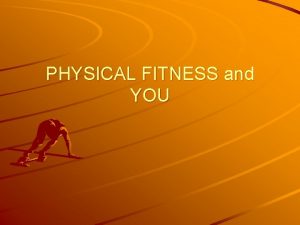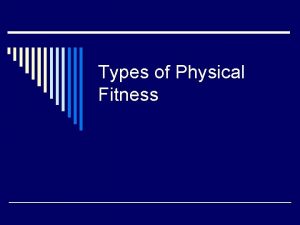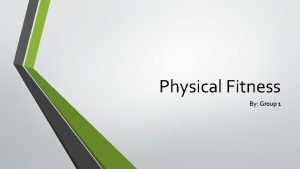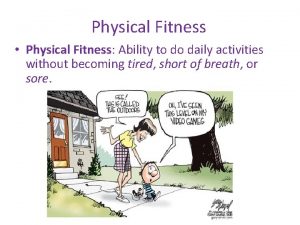SHC PE FORM 1 Fitness Testing Physical Activity

































- Slides: 33

SHC PE (FORM 1) Fitness Testing

Physical Activity Readiness Questionnaire (PAR-Q) �Increase in the amount of physical activity is normally a safe thing to do. �However, if you have an injury or physical problem it could damage your health. �PAR-Q’s are questionnaires made up of ‘yes or no’ questions. �If you answer ‘no’ to all questions, you can increase your physical activity. �If you answer ‘yes’ to any of the questions, you need to visit your doctor to make sure it is safe.

PAR-Q

Testing Components of Fitness Cooper 12 Cardiovascular Minute Run Fitness Three Ball Juggle Coordination Sit. Flexibility and Reach Test Ruler Drop. Time Test Reaction Speed 30 Metre Sprint

Testing Components of Fitness Muscular Hand Grip Test Strength Illinois Agility Test Agility Muscular One Minute Sit Up Test Endurance Standing Stork Test Balance Sergeant Jump Test Power

HEALTH related fitness tests

Cooper 12 Minute Run � ‘CARDIOVASCULAR ENDURANCE’. �This tests how far you can run in 12 minutes. �The further you run, the fitter you are. �Usually done on a athletics track. �You can also use the Treadmill Test and the Harvard Step

National Norm table

Sit and Reach Test �This tests your ‘FLEXIBILITY’ �A sit and rest box is used. �Athletes put their feet against the box, and keeping their legs flat on the floor, reach forward as far as they can. �A measurement is then taken.

National Norm table

Hand Grip Test �This tests your ‘MUSCULAR STRENGTH’ �A hand dynamometer is used in this test. �Start with the hand dynamometer by their side, grip it as hard as they can and bring it up to shoulder height. �A measurement is then taken.

National Norm table

Harvard Step Test �This tests ‘MUSCULAR ENDURANCE’ �The athlete steps up and down on the step at a rate of 30 steps per minute (every two seconds) for 5 minutes or until exhaustion. �Pulse rate is measured every 3 minutes after the test. �FORMULA – length of exercise in seconds X 100 5. 5 x pulse count

National Norm table

Body Composition �BMI (Body Mass Index) �Weight: . . . Kg �Height: . . . Cm �BMI: � Weight (kg). (Height (m) x Height (m)) =. .

National Norms

Ruler Drop Test �This tests your ‘REACTION TIME’ �A 30 cm ruler is held above the hand. �It will then be dropped and the athlete has to quickly respond and catch the ruler. �A measurement is then taken at the point where the ruler has been caught.

National Norm table

Illinois Agility Test �This test ‘AGILITY’ �Start by laying face down and on the whistle following the set route. �The athlete is timed on how quick they can complete the test. �They must be able to change direction quickly and efficiently.

National Norm table

Standing Stork Test �This tests ‘BALANCE’ �The athlete will stand on one leg, the other leg will rest on the standing leg. �Athletes will then be timed on how long they can stand without putting their foot down.

National Norm table

Sergeant Jump Test �This tests ‘POWER’ �Stand side on to the wall, keeping both feet remaining on the ground, reaches up as high as possible with one hand marks the wall with the tips of the fingers. �From a static position jump as high as possible and mark the wall with the chalk / MARKER PEN. �Distance between the two marks is measured.

National Norm table

Tennis ball test �This tests your ‘COORDINATION’ �Bounce 2 tennis balls (1 in each hand) as many times as you can without dropping them.

National Norms

Shuttle runs �This tests your ‘SPEED’ �Run as fast as you can from one cone to another �Cones are separated with a distance of 10 metres �Record the time it takes to travel the distance. It is ok to have a run and start the timing on passin gthe start line.

National Norms

Exam Q’s �Coordination is: A How well a task is completed B The ability to use two or more body parts together C The ability to change position quickly and with control D Working together as a team

Exam Q’s

Exam Q’s

Guess what card �Guess the test your partner has on their card �Once you guess it correctly you then move onto another person.

Homework �Complete the ‘Writing a Personal Exercise Programme’ worksheet. �Hand in next lesson (Monday 1 st October).
 What is physical fitness test in mapeh
What is physical fitness test in mapeh Mobil gear 634
Mobil gear 634 Uncc shc
Uncc shc Www.shc.ac.th
Www.shc.ac.th Chapter 12 physical activity and fitness
Chapter 12 physical activity and fitness Chapter 12 • lesson 1 benefits of physical activity
Chapter 12 • lesson 1 benefits of physical activity Benefits of skill related fitness
Benefits of skill related fitness Reasons for fitness testing
Reasons for fitness testing Fitness testing software
Fitness testing software Standing stork normative data
Standing stork normative data Fitness testing for sport and exercise
Fitness testing for sport and exercise Skill related physical fitness definition
Skill related physical fitness definition Presidential physical fitness award
Presidential physical fitness award Physical education grade 7
Physical education grade 7 Personal fitness merit badge workout plan
Personal fitness merit badge workout plan Two types of fitness
Two types of fitness Hexagon agility test counterclockwise time
Hexagon agility test counterclockwise time Fitness chapter 6
Fitness chapter 6 Stick drop test middle score
Stick drop test middle score Physical fitness
Physical fitness The ability to do strength work at an explosive pace.
The ability to do strength work at an explosive pace. Definition of physical activity
Definition of physical activity Physical fitness notes
Physical fitness notes Fitness components group worksheet
Fitness components group worksheet Mcoles exit standards
Mcoles exit standards Phonons of physical fitness
Phonons of physical fitness 2 types physical fitness
2 types physical fitness The ability to bend without injury or breakage
The ability to bend without injury or breakage Reaction time test
Reaction time test Skill related fitness 6 components
Skill related fitness 6 components Concept of physical training
Concept of physical training Elements of physical fitness
Elements of physical fitness Health related physical fitness definition
Health related physical fitness definition Alabama physical fitness assessment
Alabama physical fitness assessment





